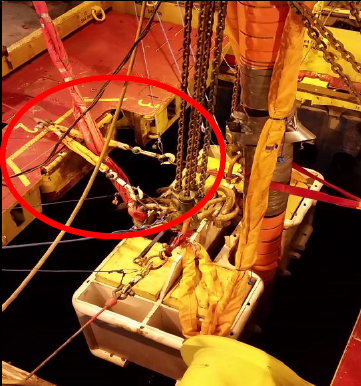Lost time injury (LTI): Rigger struck by rigging under tension
A member has reported an incident in which a rigger was struck by a winch wire and sustained a fractured arm. The incident occurred during attachment and deployment of a clump weight to a riser through the moonpool. The vessel was in the process of installing a riser as part of a large field development in 400m water depth. In order to prevent damage to the riser during deployment of the clump weight, a hold-back winch was connected to it via a two part bridle and ROV hooks. The winch would then pull the clump weight forward to allow it to be lowered without clashing with the riser.
Once deployment of the clump weight had come to a stop, tension was released from the hold-back winch, and a rigger was instructed to enter the work area and disconnect the two slack ROV hooks by pulling on release ropes. The deck supervisor then signalled for the winch operator to commence hoisting up on the winch. It was during the winch hoisting movement that the ‘extension beak’ on one of the ROV hooks got snagged. The beak parted which resulted in the two part bridle complete with ROV hooks and winch wire flying up and striking the rigger knocking him off his feet to deck.
The job was immediately stopped and the medic was called to the scene. The medic quickly diagnosed that the injured person had suffered a broken arm as a result of the incident. He was escorted to the on-board hospital and subsequently medivaced ashore to hospital where it was confirmed that he had closed fractures to the radius and ulna bones of his left arm.
Our member’s investigation is still underway, but the following preliminary findings were noted:
- Lack of hazard awareness and consequence for a ‘routine’ task;
- Low risk perception to the task because of other associated higher risk tasks in the same area;
- The need to identify and mitigate all risks associated with a Management of Change (MoC) process;
- The Management of Change process should recognise where appropriate the introduction of required additional personnel into the task.
Although this task had been conducted without incident in previous riser installations, this incident acts as a reminder of the need to remain vigilant at all times, particularly with ‘routine’ tasks which can be seen as being ‘low risk’. If there are any doubts about the safety of any operation, personnel should stop the job and ensure the situation is reassessed. All personnel should have good ‘situational awareness’ of what is going on at all times, and are encouraged to actively and positively contribute to worksite safety. If in doubt, stop the job.


Further actions:
- Deck review to identify potential snap back zones and all lines of fire zones for all winch operations;
- Review of where crew are standing whilst doing this particular job;
- Further crew briefings covering:
- Toolbox talk training and workshops
- Line of fire awareness briefing (IMCA);
- A review of the Management of Change process and Job Risk Analysis for this operation;
- Assessment of suitability of ROV hooks for deck rigging activities;
- Assessment of task procedures and risk assessments – are they available, understood and do they reflect the way the job is actually being carried out;
- Consideration of possible negative or unforeseen effects of changes made to improve how a task is done;
- Consideration of the required sequence of activities (e.g. who, what, when?) and agreement and confirmation of readiness before starting work;
- Identification of any operations/tasks which could expose personnel to a ‘line of fire’ risk.
Members may wish to refer to the following similar incidents (search words: tension):
Safety Event
Published: 21 September 2015
Download: IMCA SF 13/15
IMCA Safety Flashes
Submit a Report
IMCA Safety Flashes summarise key safety matters and incidents, allowing lessons to be more easily learnt for the benefit of all. The effectiveness of the IMCA Safety Flash system depends on Members sharing information and so avoiding repeat incidents. Please consider adding safetyreports@imca-int.com to your internal distribution list for safety alerts or manually submitting information on incidents you consider may be relevant. All information is anonymised or sanitised, as appropriate.
IMCA’s store terms and conditions (https://www.imca-int.com/legal-notices/terms/) apply to all downloads from IMCA’s website, including this document.
IMCA makes every effort to ensure the accuracy and reliability of the data contained in the documents it publishes, but IMCA shall not be liable for any guidance and/or recommendation and/or statement herein contained. The information contained in this document does not fulfil or replace any individual’s or Member's legal, regulatory or other duties or obligations in respect of their operations. Individuals and Members remain solely responsible for the safe, lawful and proper conduct of their operations.
